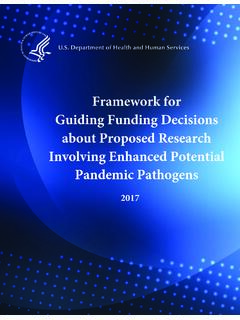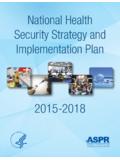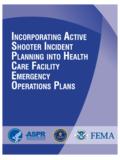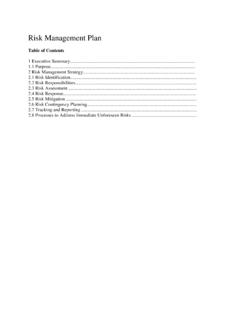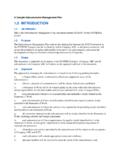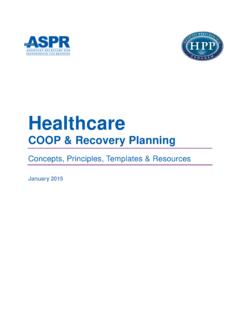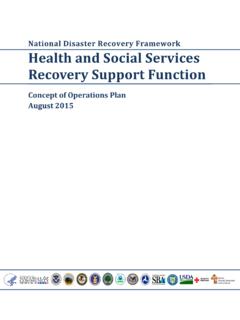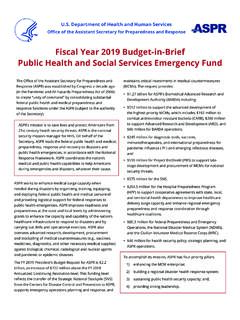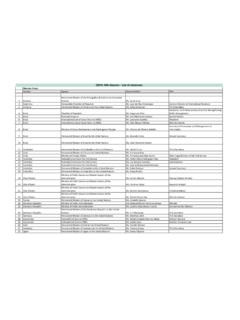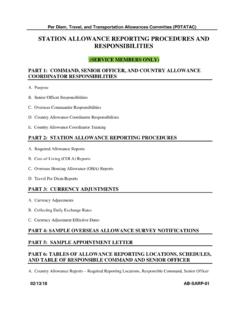Transcription of ImplementatIon plan for - Preparedness Home - PHE
1 ImplementatIon planfortHe natIonal HealtH SecurIty Strategy oF tHe unIted states oF amerIcamay 20122 CONTENTSA bbreviations .. 3 Introduction .. 6 Objective 1: Foster Informed, Empowered Individuals and Communities .. 12 Objective 2: Develop and Maintain the Workforce Needed for National Health Security .. 20 Objective 3: Ensure Situational Awareness ..26 Objective 4: Foster Integrated, Scalable Health Care Delivery Systems .. 36 Objective 5: Ensure Timely and Effective Communications .. 45 Objective 6: Promote an Effective Countermeasures Enterprise .. 53 Objective 7: Ensure Prevention or Mitigation of Environmental and Other Emerging Threats to Health.
2 62 Objective 8: Incorporate Post-Incident Health Recovery into Planning and Response .. 72 Objective 9: Work with Cross-Border and Global Partners to Enhance National, Continental, and Global Health Security .. 78 Objective 10: Ensure That All Systems That Support National Health Security Are Based on the Best Available Science, Evaluation, and Quality Improvement Methods .. 84 Appendix A. Activities for National Health Security with Notional Lead and Partner Agencies .. 89 Appendix B. Capabilities for National Health Security by Objective .. 117 Appendix C. Glossary of Key Terms .. 123 List of References .. 130 3 ABBREVIATIONS ACF Administration for Children and Families AHRQ Agency for Healthcare Research and Quality AOA Administration on Aging ASL Assistant Secretary for Legislation ASPA Assistant Secretary for Public Affairs ASPE Assistant Secretary for Planning and Evaluation ASPR Assistant Secretary for Preparedness and Response BARDA Biomedical Advanced Research and Development Authority CBRNE chemical, biological, radiological, nuclear.
3 And high explosives CDC Centers for Disease Control and Prevention CFBNP Center for Faith-Based and Neighborhood Partnerships CMS Centers for Medicare and Medicaid Services DHS department of Homeland Security DOD department of Defense DOEd department of Education DOI department of Interior DOJ department of Justice DOL department of Labor DOS department of State DOT department of Transportation EMS emergency medical services EPA Environmental Protection Agency ESAR-VHP Emergency System for Advance Registration of Volunteer Health Professionals EUA Emergency Use Authorization FCC Federal Communications Commission FDA Food and Drug Administration FEMA Federal Emergency Management Agency FETIG Federal Education and Training Interagency Group 4 FIPP Fair Information Practice Principles FSMB Federation of State Medical Boards GHSI Global Health Security Initiative HHS department of Health and Human Services HIPAA Health Insurance Portability and Accountability Act HRSA Health Resources and Services Administration ICS Incident Command System IGA Intergovernmental Affairs IHR International Health Regulations IHS Indian Health Service IIG Interim ImplementatIon Guide (NHSS)
4 IRB Institutional Review Board LIMS Laboratory Information Management Systems MCM Medical Countermeasures MCMi Medical Countermeasures Initiative MRC Medical Reserve Corps NAHERC National Animal Health Emergency Response Corps NAPAPI North American plan for Avian and Pandemic Influenza NBSHH National Biosurveillance Strategy for Human Health NCDMPH National Center for Disaster Medicine and Public Health NDMS National Disaster Medical System NEHA National Environment Health Association NHSS National Health Security Strategy NHTSA National Highway Traffic Safety Administration NIH National Institutes of Health NIMS National Incident Management System NIPP National Infrastructure Protection plan NRC National Research Council or Nuclear Regulatory Commission NSS National Security Strategy NVAC National Vaccine Advisory Committee OCR Office for Civil Rights OASH Office of Assistant Secretary of Health OD Office on Disability 5 ODNI Office of the Director of National Intelligence OGA Office of Global Affairs ONC Office of the National Coordinator for Health Information Technology OSG Office of the Surgeon General OSSI Office of Security and Strategic Information OSTP Office of Science and Technology
5 Policy OCV MRC Office of the Civilian Volunteer Medical Reserve Corps PAHPA Pandemic and All Hazards Preparedness Act PHEMCE Public Health Emergency Medical Countermeasures Enterprise PHERRB Public Health Emergency Research Review Board QHSR Quadrennial Homeland Security Review SAMSHA Substance Abuse and Mental Health Services Administration SCIP statewide communication interoperability plan SLEP Shelf Life Extension Program SNS Strategic National Stockpile UPMC University of Pittsburgh Medical Center USAID Agency for International Development USDA department of Agriculture VA department of Veterans Affairs WHO World Health Organization 6 INTR ODUCTION The National Health Security Strategy (NHSS), released by the department of Health and Human Services (HHS) in December 2009, provides the first comprehensive strategic approach to successfully prevent, protect against, mitigate, respond to, and recover from incidents with potentially negative health consequences, including terrorist attacks, natural disasters, disease outbreaks, hazardous material spills, nuclear accidents, and chemical, biological, radiological, nuclear, and high explosive (CBRNE) incidents.
6 1 The NHSS is designed to focus the efforts and unique strengths of the Nation s communities, including individuals and their families; private-sector, nongovernmental, and academic organizations; and all forms of government ( , local, state, territorial, tribal, and federal). The Interim ImplementatIon Guide identified initial tasks that provide the foundation for further planning and The purpose of this companion document, the first ImplementatIon plan , which replaces the Interim ImplementatIon Guide, is to describe the outcomes that the Nation hopes to achieve in the next four years to indicate that the NHSS s strategic objectives have been met, as well as the priority ImplementatIon activities to be undertaken to help attain that end.
7 Like the NHSS, the ImplementatIon plan is designed to draw on the collaborative efforts of all sectors of society. In short, the ImplementatIon plan describes the basic ImplementatIon approach required to achieve the strategic objectives in the NHSS. This ImplementatIon plan is consistent with Presidential Policy Directive 8 (PPD-8): National Preparedness and supports numerous core capabilities of the National Preparedness Goal including Public Information and Warning; Screening, Search, and Detection; Community Resilience; Public Health and Medical Services; Operational Communications; Fatality Management Services; and Health and Social Services, among other core capabilities.
8 A Vision of National Health Security The NHSS defines national health security as follows: National health security is achieved when the Nation and its people are prepared for, protected from, respond effectively to, and are able to recover from incidents with potentially negative health consequences. The NHSS is designed to achieve two goals, as described below. Build community resilience. Community resilience entails the capacity of the community to account for its vulnerabilities and develop capabilities that aid that community in (1) preventing, withstanding, and mitigating the stress of a health incident; (2) recovering in a way that restores the community to a state of self-sufficiency and at least the same level of health and social 1 department of Health and Human Services, National Health Security Strategy, Washington, , December 2009(accessed online May 12, 2011, at ).
9 2 department of H ealth and Human Services, Interim ImplementatIon Guide for t he Na tional He alth Security Strategy, Washington, , December 2009 (accessed online May 12, 2011, at ). 7 functioning after a health incident; and (3) using knowledge from a past response to strengthen the community s ability to withstand the next health incident. Strengthen and sustain health and emergency response systems. Services provided by public health, health care delivery, and emergency response systems develop and sustain national health security. The ability of these systems to help communities prevent, protect against, mitigate, respond to, and recover from incidents with potentially negative health consequences is supported by effective and efficient daily operations.
10 Such systems must themselves be resilient in that they should be durable, robust, responsive, adaptive to changing situations, efficient, interoperable, sustainable, and strengthened through evidence-based resource investments. The approach to achieving the national health security goals and realizing the broad vision of the NHSS within four years is best described through ten strategic objectives. These strategic objectives provide direction to guide policies, resources, programs, and activities. They are: 1. Foster informed, empowered individuals and Develop and maintain the workforce needed for national health Ensure situational Foster integrated, scalable health care delivery Ensure timely and effective Promote an effective countermeasures E
